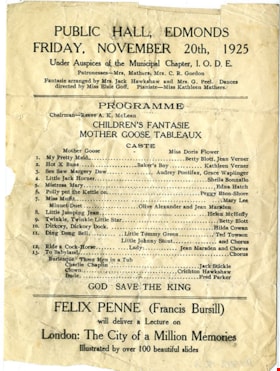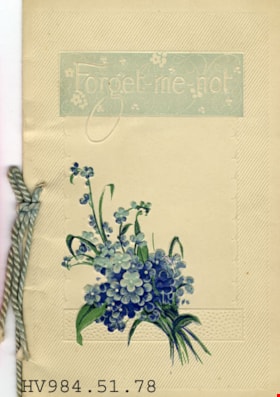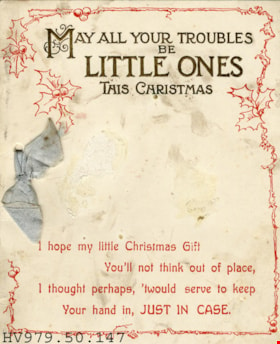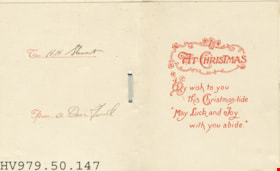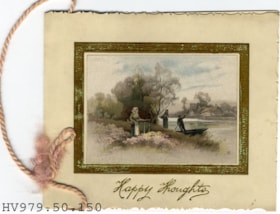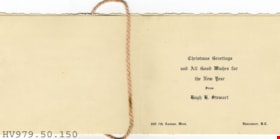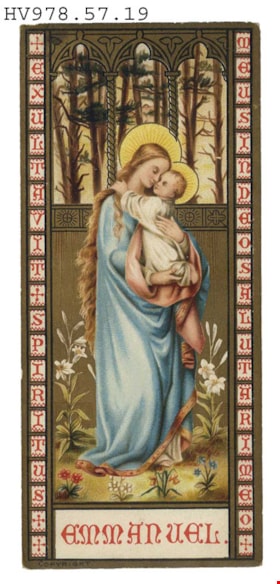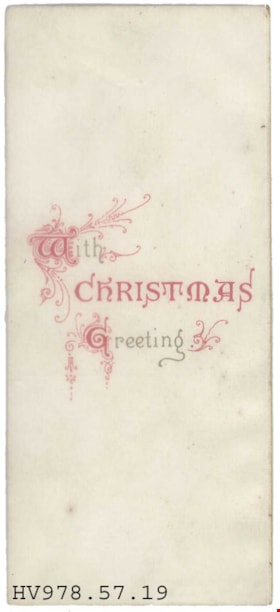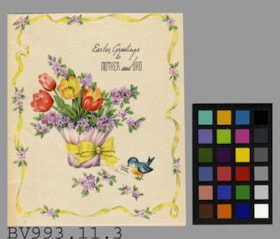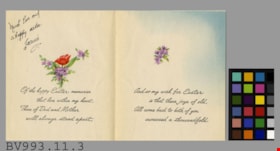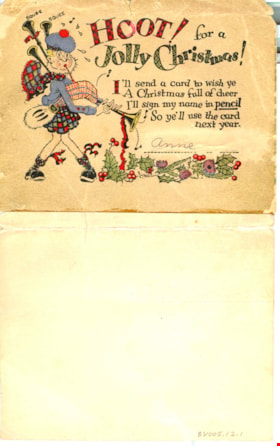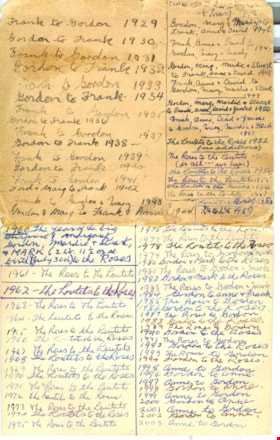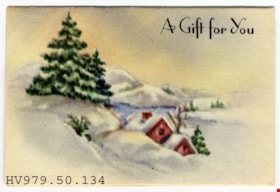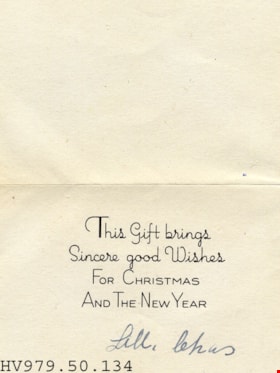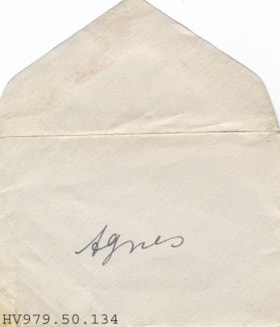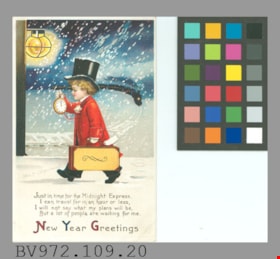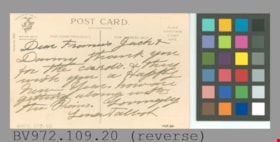More like 'Lion dance at Metrotown Mall'
Narrow Results By
Subject
- Adornment 2
- Adornment - Lapel Pins 4
- Advertising Medium 8
- Advertising Medium - Poster 1
- Advertising Medium - Signs and Signboards 5
- Agricultural Tools and Equipment 3
- Agricultural Tools and Equipment - Gardening Equipment 1
- Agriculture 4
- Agriculture - Crops 1
- Agriculture - Farms 7
- Arts 3
- Buildings 1
Chinese New Year envelope
https://search.heritageburnaby.ca/link/museumartifact89950
- Repository
- Burnaby Village Museum
- Accession Code
- BV019.16.3
- Description
- Chinese New Year envelope; red paper with gummed, fold closure at top; text in Chinese and English in gold reading: "Jagmeet Singh / Leader of Canada's NDP / Burnaby South NDP Candidate / www.jagmeetsingh.ca / Paid for and authorized by official agent of the candidate."; contains a small, square orange-flavoured candy and a thin card; card has the candidate's name and photograph on one side, and the Chinese zodiac on the other.
- Object History
- Jagmeet Singh is a Canadian lawyer and politician serving as leader of the New Democratic Party since 2017. He was elected as the Member of Parliament (MP) for the riding of Burnaby South in a February 25, 2019 by-election.
- Classification
- Merchandising T&E
- Object Term
- Envelope, Money
- Subjects
- Advertising Medium
- Holidays - Chinese New Year
- Persons - South Asian Canadians
- Officials - Elected Officials
- Celebrations
- Names
- Singh, Jagmeet
Images
Album page
https://search.heritageburnaby.ca/link/museumartifact90743
- Repository
- Burnaby Village Museum
- Accession Code
- BV005.54.755
- Description
- Album page with poster for "Feux-follets" performance, October 14, 1971; gold coloured cartridge paper with black ink
- Object History
- Album page 227 from Don Copan album/scrapbook for Burnaby Centennial '71 celebrations
- Don Copan was an active member of the Burnaby Centennial ’71 Committee and later became the founding President of the Century Park Museum Association. While a member of the Burnaby Centennial ’71 Committee, Don created a scrapbook album of photographs and ephemera documenting the Burnaby Centennial ’71 Committee’s involvement in celebrating British Columbia’s Centenary of Confederation between January and December 1971 including Burnaby’s Commemorative Project – Heritage Village (Burnaby Village Museum).
- Reference
- Photographs from the Don Copan scrapbook/album are described as part of the Donald Copan collection - Copan Album series
- Category
- 08. Communication Artifacts
- Classification
- Advertising Media
- Object Term
- Poster
Images
flyer
https://search.heritageburnaby.ca/link/museumartifact91412
- Repository
- Burnaby Village Museum
- Accession Code
- BV020.5.2133
- Description
- Flyer; mimeographed on light blue paper with black ink. Centennial logo in upper left corner of Flyer. Text reads: "BURNABY CIVIC OPERA / presents / BONANZA CREEK - 1871 / Story and Lyrics by Harry Mossfield, / with Music by Theo Gold / An exciting, fun-filled Centennial Musical / produced in B.C. and about B.C."; lists dates of performances between June 10 and June 10; "At James Cowan Theatre Centre / Gilpin and Canada Way Burnaby / ... / Burnaby Civic Opera's Musical Contribution to / this Centennial Year".
- Object History
- Event was held at the James Cowan Theatre as part of the Centennial celebrations taking place in 1971 in Burnaby. These events were organized by the Burnaby Centennial '71 Committee as part of the B.C. Centennial festivities.
- Category
- 08. Communication Artifacts
- Classification
- Advertising Media
- Object Term
- Flier
- Colour
- Blue
- Black
- Measurements
- Length: 28 cm x Width: 21.5 cm
- Country Made
- Canada
- Province Made
- British Columbia
- Site/City Made
- Burnaby
- Publication Date
- May 1971
Images
poster
https://search.heritageburnaby.ca/link/museumartifact91077
- Repository
- Burnaby Village Museum
- Accession Code
- BV020.5.1801
- Description
- Poster; black ink on newsprint; text reads: "GOLDENGLOW / the itinerant Vaudevillians / celebrating / GOLD RUSH GAEITY / in / B.C. GOLD / ALL HEADLINE PERFORMERS / Mr. Edd Wright / a classica and sublime impressario / Miss Roma Hearn/ FLAWLESS FINESE / Miss Christine Willes / Blithe Characterizations / Mr Ed Milaney / brawling boisterous buffoonery / Miss Sylvia Granda / gorgeous majestic quality / Miss Claire Thompson / an assuredly agile attraction / Miss Janine Kandborg / Gently Demure Refinement / Mr Kirk Mitchell / ARTISTICALLY ACCURATE ACTING / with Kathleen Wright at the piano / ONE INTERVAL OF FIFTEEN MINUTES / Directed by C.M. (Ink) Sinclair / Choreographed by Sylvia Granda & Dan C.../ Music Directed by Kathleeen Wright, Stag.../ aged by Geran Capewell with assistance... / Craig Trudell, Publized by Nick Orchard / House Managed by Cathy Borg. / Program courteously supplied by CPA..."; bottom portion of flyer is torn
- Object History
- Item was found in Burnaby Village Museum printshop along with other Heritage Village / Burnaby Village Museum ephemera created between 1971 and 1990. Poster may have been printed in the Burnaby Village Museum printshop. Performance may have been performed on stage inside Heritage Village.
- Category
- 08. Communication Artifacts
- Classification
- Advertising Media
- Object Term
- Poster
- Measurements
- 41.5 x 17.7 cm
- Maker
- Burnaby Village Museum
- Country Made
- Canada
- Province Made
- British Columbia
- Site/City Made
- Burnaby
- Publication Date
- [197-]
Images
program and insert
https://search.heritageburnaby.ca/link/museumartifact91418
- Repository
- Burnaby Village Museum
- Accession Code
- BV020.5.2136
- Description
- Program and insert; program- gold coloured cardstock cover with black text and illustrations; 6 p. double sided; stapled spine; front cover reads: "burnaby civic opera / presents / Bonanza Creek / 1871 / story & lyrics by Harry Mossfield / music by Theo Gould / June 10-11-12--18-19-20". White pages within; illustration on front cover of two men standing on a board walk outside a building with sign, "Molly's Saloon", one of the men is on the ground. insert - mimeographed on white paper; includes logo of BC Centennial and reads "burnaby Civic Opera Company gratefully acknowledges / the support of the BURNABY CENTENNIAL '71 COMMITTEE".
- Object History
- Program from "Bonanza Creek 1871" which was an original musical contribution to British Columbia's Centennial year festivities. The peformance took place at James Cowan Theatre in Burnaby.
- Category
- 08. Communication Artifacts
- Classification
- Documentary Artifacts - - Other Documents
- Object Term
- Program
- Colour
- Gold
- White
- Black
- Measurements
- Length: 21.5 x Width: 14 cm
- Maker
- Cue publication
- Country Made
- Canada
- Province Made
- British Columbia
- Site/City Made
- Burnaby
- Publication Date
- June 1971
Images
brochure
https://search.heritageburnaby.ca/link/museumartifact91416
- Repository
- Burnaby Village Museum
- Accession Code
- BV020.5.2137
- Description
- Burnaby School Concerts - B.C. Centennial brochure; trifold on glossy paper. Front of Flier reads: "Burnaby Schools' / Concert Band / BRITISH COLUMBIA"; centre of cover includes B.C. Centennial logo in yellow on blue background with dogwood flower and three 'c' s; text at bottom on front cover reads: "CENTENNIAL YEAR TRIP / to / DISNEYLAND AND SAN DIEGO". Content within Flier includes Burnaby - Community Development Information, Map of Burnaby District Municipality and The Burnaby School's Concert Band. Inside flap title reads: "HIGHLIGHTS OF AN EXCITING / CENTENNIAL YEAR; back of pamplet includes a list of Centennial events and is titled: "CENTENNIAL / CELEBRATIONS / May to November, 1971".
- Object History
- Burnaby School's Concert Band was organized in the fall of 1969 to provide further challenge and opportunity for interested music students throughout the Burnaby School District. Students represented eleven Junior and Senior Secondary Schools instrumental programs with the majority of students in grades ten to twelve. The Burnaby Schools' Concert Band performed for a number of concerts including the New Westminster May Day and Pacific National Exhibtion parades and during the Royal visit to Burnaby in May 1971. In April 1971, the band performed at the Music Education Conference (Western Division) held in San Diego. The Band auxilliary formed in May 1970 and became a registered society.
- Category
- 08. Communication Artifacts
- Classification
- Advertising Media
- Object Term
- Brochure
- Colour
- White
- Blue
- Measurements
- Length: 23 cm x Width: 30 cm; folded to Length: 23 cm x Width: 10 cm
- Country Made
- Canada
- Province Made
- British Columbia
- Publication Date
- 1971
Images
poster.
https://search.heritageburnaby.ca/link/museumartifact82124
- Repository
- Burnaby Village Museum
- Accession Code
- BV020.5.2139
- Description
- Poster; screen printed; light blue ink on white paper. Poster is an advertisement for the Official Sod Turning ceremony for Heritage Village and other associated events on April 11, 1971. B.C. Centennial logo with dogwood flower in upper left corner of Poster. Poster reads: "BURNABY CENTENNIAL / '71 COMMITTEES / OFFICIAL SOD TURNING... / SUNDAY APRIL 11th 245 pm / MUSEUM-HERITAGE PARK Complex / EASTER EGG HUNT", / CENTURY GARDENS 1:30 pm./ ANTIQUE Car Club's / Annual Easter Parade / WIND-UP AT COWAN CENTRE 2:30 pm / REFRESHMENTS 4 pm / COME-SEE & CELEBRATE / IT'S YOUR / CENTENNIAL PROJECT"
- Object History
- Poster was created by the Burnaby Centennial '71 Committee. The sod turning even for the Heritage Village Museum, Easter Egg Hunt and Easter Parade were part of the Burnaby Centennial celebrations taking place in Burnaby. These events were organized by the Burnaby Centennial '71 Committee as part of the B.C. Centennial festivities.
- Category
- 08. Communication Artifacts
- Classification
- Advertising Media
- Object Term
- Poster
- Colour
- White
- Blue
- Measurements
- Length 45.5 cm x Width: 30.5 cm
- Country Made
- Canada
- Province Made
- British Columbia
- Site/City Made
- Burnaby
- Publication Date
- 1971
Images
Interview with Dr. Sadhu Binning
https://search.heritageburnaby.ca/link/museumdescription19348
- Repository
- Burnaby Village Museum
- Date
- [1931-2022] (interview content), interviewed 25 Nov. 2022
- Collection/Fonds
- Burnaby Village Museum fonds
- Description Level
- Item
- Physical Description
- 3 sound recordings (wav) (75 min., 56 sec.) + 1 sound recording (mp3) (75 min., 57 sec.)
- Scope and Content
- Item consists of an oral history interview with Dr. Sadhu Binning conducted by Anushay Malik with assistance from Burnaby Village Museum Assistant Curator, Kate Petrusa. The interview opens with introductions and how the content of the interview can be drawn on by Burnaby Village Museum for future …
- Repository
- Burnaby Village Museum
- Collection/Fonds
- Burnaby Village Museum fonds
- Series
- Museum Oral Histories series
- Description Level
- Item
- Physical Description
- 3 sound recordings (wav) (75 min., 56 sec.) + 1 sound recording (mp3) (75 min., 57 sec.)
- Material Details
- Interviewer: Anushay Malik Co Interviewer and technical support: Kate Petrusa Interviewee: Dr. Sadhu Binning Location of Interview: Love farmhouse at Burnaby Village Museum Interview Date: November 25, 2022 Total Number of tracks: 3 Total Length of all Tracks: (1:15:57) Digital master recordings (wav) were recorded onto three separate audio tracks, edited and merged together and converted to mp3 for access on Heritage Burnaby
- Scope and Content
- Item consists of an oral history interview with Dr. Sadhu Binning conducted by Anushay Malik with assistance from Burnaby Village Museum Assistant Curator, Kate Petrusa. The interview opens with introductions and how the content of the interview can be drawn on by Burnaby Village Museum for future exhibits and for researchers to learn more about the history of the South Asian community in Burnaby. During the interview, Dr. Binning shares his ancestral background along with his relatives' and his own personal experiences as a South Asian immigrant living and working in British Columbia and Burnaby. Dr. Binning conveys that he’s a Burnaby resident who’s lived in Burnaby since 1973 and that his children were born here. Binning shares his ancestral heritage beginning with his uncle Dhana Singh who emigrated from Punjab to British Columbia in 1931 and began working in the forest industry. He explains how Dhana Singh and another partner owned, operated and worked in small sawmills in the vicinity of Kamloops, Williams Lake and also on Vancouver Island. Binning conveys that in the beginning Dhana Singh and many other South Asian immigrants were not legal residents until 1938. In 1938, about 350 South Asian immigrants (mainly Punjabi) gathered resources to hire a lawyer to obtain permanent residency. Binning mentions that one of the notable South Asians in the group who was also a close friend of his uncle, was Darshan Singh Sangha, a trade unionist who was a founding member of the International Woodworkers of America (IWA) union and an active member of the Communist Party of Canada. Binning conveys how Darshan Singh Sangha returned to India in 1947 to be a part of the revolution, how he was very active in the communist movement in India. While in India, Darshan Singh Sangha, was known as Canadian and thereby adopted “Canadian” as his surname, becoming “Darshan Singh Canadian”. Binning further explains that his uncle Dhana Singh Sangha returned to India in 1951, married and came back to B.C. in 1957 bringing with him, his wife and children. In 1960, with the support of his uncle, Binning’s father, Jit Singh Binning immigrated to British Columbia and began working in sawmills in the lower mainland, Kamloops, Quesnel and on Vancouver Island. Binning clarifies that his uncle, Dhana Singh was able to immigrate to Canada with the support of his cousins from the Tarker Singh Bains family. Binning further describes Darshan Singh Sangha’s involvement with the Communist party and the IWA and how the majority of the members were from the forest industry. As an active and prominent member of the labour movement, Darshan Singh Sangha fought for the rights of South Asians and Chinese who working in the industry and facing racism, unfair wages and discriminatory practices. Binning describes how Darshan Singh Sangha wrote a book in English in 1943, titled “Rise of the New Asia”. Binning conveys how immigrants of Chinese and South Asian decent didn’t have the right to vote in British Columbia and how Darshan Singh Sangha was instrumental in obtaining the right to vote in British Columbia, although he was never given the credit. Binning describes his uncle Dhana Singh as a likeable guy with many friends, first living in Kamloops before moving to Vancouver. Binning imparts how the sport of wrestling is a popular Punjabi sport along with Punjabi kabaddi. He conveys that his uncle became involved in wrestling while working in sawmills. South Asian immigrants had to do physical labour working in sawmills, the work could be tough and could often lead to physical fights. A number of South Asian immigrants working in the mills already had experience as wrestlers from back home. Dhana Singh later left the lumber industry to work in the agriculture sector. Binning explains how immigration rules changed in the 1960s which lead to larger numbers of South Asians immigrating to Canada. Many of these new immigrants were educated and politically conscious. All of these new immigrants faced racism but being politically conscious from an independent India and with the ability to speak English they organized themselves to fight for their rights. Binning imagines the items that his uncle and his father may have brought with them in their suitcase when immigrating to Canada. Binning describes three items, including a rajai (a blanket with cotton inside that is sewn together), a bistra (small attaché case or trunk) and a piece of cloth to lie on. Binning further describes the roles in Indian society as caste divisions and that it was usually women’s work in making the rajais. Binning recollects the locations that his father and his family lived after coming to Vancouver. Binning explains that a few years after living together in Vancouver, he and his family moved to Burnaby in 1973 to be closer to his Dr. Binning’s wife, Jagdish Binning’s family. Dr. Binning and family lived in a house in Burnaby located on Irmin Street near Royal Oak between 1973 and 1987. While living at this house their children attended McPherson Park Junior High School and later Burnaby South Secondary School. Binning reflects on some of the racism that he and his family have faced while living in Burnaby which led him to write a poem that he published in 1994 titled “No More Watno Dur”. Binning explains the meaning of the title “Watan” meaning “country and everybody” “a country far way from the motherland”. Binning explains the origins of the magazine “Watan” that was started by a friend in 1973. The magazine got its roots in Vancouver in 1973 from an organization called the “Punjabi Literary Association”. Binning became the editor of the magazine in 1976 and his friend joined him as assistant editor in 1978. Binning continued to work as editor until 1983 or 1984 when he returned to school to complete his Bachelor’s degree and Master’s degree. Binning describes the origins of the “Vancouver Sath” that was formed by a small group of South Asians around 1982. Binning was a founding member of the organization and held meetings and rehearsals at his house in Burnaby. Vancouver Sath first started out as an informal discussion forum by a group of politically conscious Punjabi writers and activists. Binning talks about issues and problems that Vancouver Sath addressed including; racism as well as domestic violence in the South Asian community. Binning explains how he and Sukhwant Hundal wrote articles on these issues and others that were happening in the South Asian community in Canada. Binning talks about how in 1983, the group was inspired to begin performing theatrical works after consulting with Gursharan Singh who was from a well known theatrical group from Punjab who were performing in Vancouver. In the beginning the Vancouver Sath’s plays were focused on the problems in Punjab but they soon decided to address social issues in their own South Asian community here in Canada. Binning summarizes and draws attention to, some of the plays that Vancouver Sath has written and performed including; “Picket Line”, about Punjabi women farmworkers’ rights; “Lattan de Bhoot”, about domestic abuse; “A Crop of Poison”; “Kihda Viah” (English translation- “Whose Marriage”) about arranged marriage and others about social issues in the South Asian community. The plays were performed in public schools and community centres in Vancouver and Richmond, Simon Fraser University and some were also performed in Toronto, Calgary and Williams Lake. Binning mentions some of the traditional foods that he likes to eat and where he and his family have shopped to find ingredients. He recalls how his mother, Gurmaje Kaur Binning did all of the cooking and was often cooking all day long. In the sixties, the Binning family address on 13th Avenue in Vancouver was also used as a postal address for many friends and family who’d recently immigrated. When these friends dropped by to pick up their mail, his mother often provided them with tea and food. After Binning and his wife, Jagdish moved to their own home in 1973, he shared in some of the shopping and cooking but his wife did the majority of the work due to his busy schedule. The interview closes with Binning providing an explanation of how “Watno Dur” magazine changed it’s name to “Watan” magazine. Binning reflects on how this came to be, when he made the decision to get an education in Canada and to stay here, not just as a “Canadian” but as a “Punjabi Canadian.
- History
- Interviewee biography: Dr. Sadhu Binning was born on May 10, 1947 to mother Gurmej Kaur and father Jeet Singh Binning. Due to lack of proper records management in India at the time of his birth, it is believed that he was actually born sometime in December of 1947. He grew up alongside two brothers and one sister in a village located in Kapurthala, Punjab. Dr. Binning attended secondary school in the nearby city of Phagwara, Punjab although he did not complete his education here. Throughout his childhood, he enjoyed reading both Punjabi and Hindi novels and learned how to read Urdu as well. Dr. Binning’s uncle, Dhana Singh immigrated to Canada in 1933 and returned to India in 1953. When Dhana Singh returned to Canada in 1957, he sponsored Dr. Binning’s father, Jeet Singh Binning to immigrate. Dhana Singh co-owned a few saw mills in British Columbia and also worked in the truck driving industry. Dr. Binning remembers that some people who had lived in Canada would visit their village and that they appeared to be strong and healthy and looked happy. He also noticed that they would eat meat, so whenever they would visit there would be meat available. In 1967, when he was nineteen and a half years old, Dr. Binning immigrated Canada to join his father. He recalls his father and uncle and a friend arriving at the airport to pick him up. During his first few days, Dr. Binning made the decision to remove his turban and beard upon receiving advice from his uncle. Dr. Binning first obtained work on a farm in Abbotsford, working alongside his mother. While working, Dr. Binning also attended English classes in Vancouver. Dr. Binning’s Uncle Dhana Singh worked in a Vancouver saw mill and tried to help find work for his nephew but was unsuccessful. Dr. Binning soon found work at a saw mill in Avola and worked there until the end of the summer until a friend helped find him work in a saw mill in North Vancouver. During his free time, he enjoyed camping with friends. In 1970, Dr. Binning left the saw mill after obtaining a job at the post office. The post office offered lower wages than working at the mill but Dr. Binning believed that he would become more educated working here. While working as a postman, Dr. Binning recalls facing a lot of discrimination and racism and was often referred to as a ‘Paki’ multiple times a day. In 1973, Dr. Binning married Jagish Sihota. Sadhu and Jagdish originated from nearby villages in India and met each other in Canada. Dr. Binning’s wife, Jagdish worked at the Royal Bank of Canada for thirty years until her retirement. While working, she also looked after the household and their son and daughter. Jagdish also handwrote a magazine, “Watno Dur’ (English translation: ‘away from homeland’) which was distributed in the community. In 1976, Dr. Binning became the editor of the magazine and the name was later changed to “Watan’ as they had accepted their new homeland of Canada. While working at the post office, Dr. Binning also attended night school starting in eighth grade. After receiving his high school diploma, he was accepted to Simon Fraser University and earned a Bachelor of Arts degree with a double major in Anthropology and Sociology and in 1986 he obtained a Masters degree from Simon Fraser University. While attending university, Dr. Binning was very active within the community and wanted to work to improve society. He first thought that he would return to India to contribute and improve rights in his homeland but upon seeing the prevalence of the movements in Canada, he realized that work needed to be done here too. In 1983, Dr. Binning became a founding member and contributor to a theatrical collective known as “Vancouver Sath”. The theatrical group produced plays that represented societal issues and were invited to perform at multiple conferences throughout British Columbia and Canada. The group focused and acknowledged the many issues in Punjab and in Canada. One of the plays that the group produced focused on the exploitation of Punjabi women who worked on farms in Canada. Dr. Binning continued to be involved as an integral member of Vancouver Sath until 1995. Over the years, Dr. Binning has strongly lobbied for Punjabi language education and between 1988 and 2008 he worked as Punjabi instructor at the University of British Columbia. He first worked as a teaching assistant at UBC under Dr. Harjot Oberoi and due to low wages, he simultaneously worked at the Post Office. In 2019, Dr. Binning received an Honorary Doctor of Letters from UBC in recognition of his work. Since 1973, Dr. Binning has lived in Burnaby and has resided in the same home that he and his wife Jagdish purchased in 1987. In his free time, he enjoys cycling, watercolour painting, travelling abroad and going on road trips. Interviewer biography: Anushay Malik is labor historian with a geographical focus on South Asia. Anushay studied at the University of London and was a research fellow at the International Institute of Social History in Amsterdam, Netherlands. In 2014, Anushay moved back to her native Pakistan and joined Lahore University of Management Services as an Assistant Professor. In 2023, Anushay is a visiting scholar at Simon Fraser University and lives in Burnaby with her family. Anushay was a co-curator of the Burnaby Village Museum exhibit “Truths Not Often Told: Being South Asian in Burnaby”.
- Creator
- Burnaby Village Museum
- Subjects
- Industries - Logging/lumber
- Industries - Forestry
- Foods
- Migration
- Organizations - Societies and Clubs
- Organizations - Unions
- Persons - South Asian Canadians
- Performances
- Performances - Dramatic Performances
- Social Issues
- Social Issues - Racism
- Names
- Binning, Dr. Sadhu
- Binning, Gurmaje Kaur
- Binning, Jit Singh
- Binning, Jagdish
- Sangha, Darshan Singh
- Canadian Farmworkers Union
- Hundal, Sukhwant
- Sangra, Harjinder
- Singh, Dhana
- Vancouver Sath
- Responsibility
- Petrusa, Kate
- Malik, Anushay
- Accession Code
- BV022.29.3
- Access Restriction
- No restrictions
- Reproduction Restriction
- No known restrictions
- Date
- [1931-2022] (interview content), interviewed 25 Nov. 2022
- Media Type
- Sound Recording
- Notes
- Title based on contents of item
- Transcription available on Heritage Burnaby
Documents
Audio Tracks
Interview with Dr. Sadhu Binning, [1931-2022] (interview content), interviewed 25 Nov. 2022
Interview with Dr. Sadhu Binning, [1931-2022] (interview content), interviewed 25 Nov. 2022
https://search.heritageburnaby.ca/media/hpo/_Data/_BVM_Sound_Recordings/Oral_Histories/2022_0029_0003_004.mp3Interview with Joanne Smith
https://search.heritageburnaby.ca/link/museumdescription19601
- Repository
- Burnaby Village Museum
- Date
- [1986-2023] (interview content), interviewed 11 May 2023
- Collection/Fonds
- Burnaby Village Museum fonds
- Description Level
- Item
- Physical Description
- 1 sound recording (wav) (24 min., 55 sec.) + 1 sound recording (mp3) (24 min., 55 sec.)
- Scope and Content
- Item consists of a recording of an oral history interview with Joanne Smith conducted by Burnaby Village Museum Registrar and Researcher, Eric Damer. 0:00 - 04:04 Joanne Smith provides a brief overview of her immigration story and how she and her husband Stanis came to emigrate from South Africa t…
- Repository
- Burnaby Village Museum
- Collection/Fonds
- Burnaby Village Museum fonds
- Series
- Museum Oral Histories series
- Subseries
- Many Voices Project Interviews subseries
- Description Level
- Item
- Physical Description
- 1 sound recording (wav) (24 min., 55 sec.) + 1 sound recording (mp3) (24 min., 55 sec.)
- Material Details
- Interviewer: Eric Damer Interviewee: Joanne Smith Location of Interview: Burnaby Village Museum Interview Date: May 11, 2023 Total Number of tracks: 1 Total Length of all Tracks: 24:55 Photograph information: Joanne and Stanis Smith cycling on the Salt Flats, Argentina Digital master recording (m4a) was converted to mp3 for access on Heritage Burnaby
- Scope and Content
- Item consists of a recording of an oral history interview with Joanne Smith conducted by Burnaby Village Museum Registrar and Researcher, Eric Damer. 0:00 - 04:04 Joanne Smith provides a brief overview of her immigration story and how she and her husband Stanis came to emigrate from South Africa to Canada in 1986. Joanne explains that they decided to leave South Africa during the Apartheid era and applied to several countries with Canada being their top choice. Joanne relates that they were accepted to Canada based on her professional skills as an occupational therapist. Joanne talks about what she liked about living in South Africa and how she especially loved walking in the game reserves. 04:05 - 11:44 Joanne provides background on her ancestors migration, her life in South Africa and details on her profession. Joanne imparts that her ancestors immigrated to South Africa from Latvia at the turn of the century to avoid conscription and for increased opportunities. Joanne provides a brief overview of her life in South Africa, places that she lived and her education. Joanne provides details and background regarding her practice as an occupational therapist. Joanne explains how she specializes in hand therapy but also works with animals and other varied treatments. 11:45 - 19:29 Joanne talks about her life in Burnaby. Joanne recollects how her family ended up living in the Capitol Hill neighbourhood and provides a brief overview of her community involvement including the Parent Advisory Committee (PAC) and the Community Advisory Committee. Joanne shares some of her interests including; riding her tandem bicycle with her husband Stanis, thier love of opera and the symphony, attending concerts in Deer Lake Park and visiting Confederation with her grandchild. Joanne conveys that they like to support the local arts and that they commissioned a twig sculpture for their garden from local artist, Nickie Lewis. 19:30 - 24:55 Joanne shares that ten years after immigrating that they were able to bring family relations including Stanis' parents and brother. Joanne describes the benefits of having Stanis' parents residing with them and provides details on Stanis' parents community involvement in Burnaby. Joanne reflects on her association with her Jewish heritage. Joanne conveys that they aren’t religious but have maintained a few cultural aspects of their Jewish heritage including celebrating bat mitzvahs for both of their daughters and the importance of the Yiddish language. Joanne reflects on what she likes about living in Burnaby and how it’s changed over the 30 years that she’s lived here.
- History
- Interviewee biography: Joanne was born in Pretoria, South Africa, in 1958 and also spent some time in Klerksdorp and Johannesburg. Her formal education led to a career in occupational therapy, specializing in hand therapy. Uncomfortable with the social and political climate of South Africa at the time, she and her husband Stanis left for Canada in 1986. They soon settled in North Burnaby, where Joanne had a long-time friend, to pursue their respective careers and raise a family. The Smiths brought Stanis’s parents to Burnaby about 1996 and together built a new home. Joanne has been involved in school and community activities, enjoys Burnaby’s parks, and supports local fine arts, particularly music and performing arts. Interviewer biography: Eric Damer is a Burnaby Village Museum Interpreter, Museum Registrar, Researcher and Blacksmith. Eric pounded hot steel for the first time in 1977 in junior high. Fifteen years later, he joined Burnaby Village Museum where he has smithed for three decades. He also provides historical research for museum exhibits and special projects. Outside the museum, Eric is a social historian with a special interest in educational history.
- Creator
- Burnaby Village Museum
- Subjects
- Persons - Jewish Canadians
- Migration
- Religions - Judaism
- Geographic Features - Parks
- Arts
- Performances
- Performances - Concerts
- Sports - Cycling
- Names
- Smith, Joanne
- Smith, Stanis
- Responsibility
- Damer, Eric
- Geographic Access
- Deer Lake Park
- Confederation Park
- Accession Code
- BV023.16.5
- Access Restriction
- No restrictions
- Reproduction Restriction
- No known restrictions
- Date
- [1986-2023] (interview content), interviewed 11 May 2023
- Media Type
- Sound Recording
- Historic Neighbourhood
- Capitol Hill (Historic Neighbourhood)
- Notes
- Title based on contents of item
- Transcription available on Heritage Burnaby
Images
Documents
Audio Tracks
Interview with Joanne Smith, [1986-2023] (interview content), interviewed 11 May 2023
Interview with Joanne Smith, [1986-2023] (interview content), interviewed 11 May 2023
https://search.heritageburnaby.ca/media/hpo/_Data/_BVM_Sound_Recordings/Oral_Histories/2023_0016_0005_003.mp3Interview with Sadhu Binning and Sukhwant Hundal
https://search.heritageburnaby.ca/link/museumdescription19603
- Repository
- Burnaby Village Museum
- Date
- 1967-2023 (interview content), interviewed 29 May 2023
- Collection/Fonds
- Burnaby Village Museum fonds
- Description Level
- Item
- Physical Description
- 2 sound recordings (wav) (93 min., 7 sec.) + 1 sound recording (mp3) (92 min., 57 sec.)
- Scope and Content
- Item consists of a recording of an oral history interview with Sadhu Binning and Sukhwant Hundal, founders of Vancouver Sath conducted by Burnaby Village Museum Registrar, James Binks. The interview is taking place at the Burnaby Village Museum's exhibit "Truths not Often Told: Being South Asian in…
- Repository
- Burnaby Village Museum
- Collection/Fonds
- Burnaby Village Museum fonds
- Series
- Museum Oral Histories series
- Subseries
- Many Voices Project Interviews subseries
- Description Level
- Item
- Physical Description
- 2 sound recordings (wav) (93 min., 7 sec.) + 1 sound recording (mp3) (92 min., 57 sec.)
- Material Details
- Interviewer: James Binks Interviewee: Sadhu Binning and Sukhwant Hundal Location of Interview: Burnaby Village Museum Interview Date: May 29, 2023 Total Number of tracks: 2 Total Length of all Tracks:1:33:07 Digital master recordings (wav) were recorded onto two separate audio tracks, edited and merged together into one track and converted to mp3 for access on Heritage Burnaby
- Scope and Content
- Item consists of a recording of an oral history interview with Sadhu Binning and Sukhwant Hundal, founders of Vancouver Sath conducted by Burnaby Village Museum Registrar, James Binks. The interview is taking place at the Burnaby Village Museum's exhibit "Truths not Often Told: Being South Asian in Burnaby". The interview focuses on the history of "Vancouver Sath" as well as literary works created by Hundal and Binning and the Punjabi literary magazine "Watno Dur" and "Watan". 00:00 - 13:30 Interview opens with brief introductions and information on Sadhu Binning, Sukhwant Hundal and Vancouver Sath provided by the interviewer, James Binks. Interviewees Sadhu Binning and Sukhwant Hundal describe how they met and what they were focused on prior to the formation of the organization Vancouver Sath. Binning briefly describes how he became involved as a writer in the literary world and recalls how he published his first poem in an Indian literary magazine in 1972. Hundal describes how he immigrated to Canada from Punjab in 1975, the various industries that he worked in as a new immigrant and his interest in literature with a focus on social issues. Hundel describes how he developed a relationship with Sadhu Binning after his short story was published in "Watno Dur" literary magazine which in turn lead to his involvement with the Punjabi Literary Association and becoming co-editor of "Watnu Dur". 13:31 – 27:44 Hundal provides more background on his life as a South Asian immigrant, working in sawmills and completing a diploma in Power and Process Engineering and how he first became interested in literature while living in India. Binning and Hundal both share their insights into the formation of Vancouver Sath and provide details on their involvement with the Punjabi literary publication “Watnu Dur”. Binning describes how the inspiration for the formation of the Vancouver Sath organization came from India and that Binning, Hundal and some other members of the Punjabi Literary Association decided to form their own group where they could have more informal discussions around social, political and literary issues. 27:45 – 43:31 Binning describes how the political issues that were happening in Punjab between 1978 and 1983 influenced discussions in the South Asian community whereas prior to 1978 there was more focus on local issues that new immigrants were facing. Binning conveys how their work with Vancouver Sath endeavored to focus more on local issues and Hundal conveys how they made the decision to begin producing theatrical works rather than just written works to reach a wider audience. Hundal and Binning share names of the people that were involved with Vancouver Sath and describe some of the early plays that they performed. Binning describes the foundations of the organization where they worked together as a collective making decisions in producing and performing the works with Binning and Hundal taking on the responsibility for the written work. They talk about their first paid experience being invited to perform a few of their plays at the Vancouver Folk Music Festival. 43:32 – 55:17 Hundal and Binning describe how they continued to support themselves financially since they weren’t making money from Vancouver Sath. Binning and Hundal provide further details on how their collective worked with the process of writing the plays and presenting and discussing details with the Vancouver Sath community before performing to an audience. Hundal talks about the transition that the magazine “Watno Dur” took in 1986 which lead to renaming it “Watan”. Hundal and Binning discuss how in 1992 and 1993 they decided to try to get more young people involved and began publishing a magazine in English called “Ankur”. They describe the content and list some of the authors who contributed to the magazine. 55:18 – 1:20:12 Hundal and Binning provide background details on the author of “Maluka”, Sadhu Singh Dhami and describe the details that lead them to translating the book into Punjabi, touring with the author and adapting the novel into a play which Vancouver Sath performed. Binning and Hundal describe and discuss other plays that Vancouver Sath performed including some plays that were recorded and broadcast over local radio stations. 1:20:13 – 1:32:57 Binning and Hundal reflect on what lead Vancouver Sath to discontinue theatrical performances in the mid 1990’s. Binning and Hundal state how they are both still very involved in publishing literary works but no longer perform theatrical works. Binning and Hundal describe some of their literary works and projects that they’ve been involved in and also reflect on and describe the current theatre scene in the South Asian community. Hundal conveys that even though they no longer call themselves “Vancouver Sath” they continue to enjoy working as a collective discussing literary works and ideas.
- History
- Interviewees' biographies: Dr. Sadhu Binning was born on May 10, 1947 to mother Gurmej Kaur and father Jeet Singh Binning. Due to lack of proper records management in India at the time of his birth, it is believed that he was actually born sometime in December of 1947. He grew up alongside two brothers and one sister in a village located in Kapurthala, Punjab. Dr. Binning attended secondary school in the nearby city of Phagwara, Punjab although he did not complete his education here. Throughout his childhood, he enjoyed reading both Punjabi and Hindi novels and learned how to read Urdu as well. Dr. Binning’s uncle, Dhana Singh immigrated to Canada in 1933 and returned to India in 1953. When Dhana Singh returned to Canada in 1957, he sponsored Dr. Binning’s father, Jeet Singh Binning to immigrate. Dhana Singh co-owned a few saw mills in British Columbia and also worked in the truck driving industry. Dr. Binning remembers that some people who had lived in Canada would visit their village and that they appeared to be strong and healthy and looked happy. He also noticed that they would eat meat, so whenever they would visit there would be meat available. In 1967, when he was nineteen and a half years old, Dr. Binning immigrated Canada to join his father. He recalls his father and uncle and a friend arriving at the airport to pick him up. During his first few days, Dr. Binning made the decision to remove his turban and beard upon receiving advice from his uncle. Dr. Binning first obtained work on a farm in Abbotsford, working alongside his mother. While working, Dr. Binning also attended English classes in Vancouver. Dr. Binning’s Uncle Dhana Singh worked in a Vancouver saw mill and tried to help find work for his nephew but was unsuccessful. Dr. Binning soon found work at a saw mill in Avola and worked there until the end of the summer until a friend helped find him work in a saw mill in North Vancouver. During his free time, he enjoyed camping with friends. In 1970, Dr. Binning left the saw mill after obtaining a job at the post office. The post office offered lower wages than working at the mill but Dr. Binning believed that he would become more educated working here. While working as a postman, Dr. Binning recalls facing a lot of discrimination and racism and was often referred to as a ‘Paki’ multiple times a day. In 1973, Dr. Binning married Jagish Sihota. Sadhu and Jagdish originated from nearby villages in India and met each other in Canada. Dr. Binning’s wife, Jagdish worked at the Royal Bank of Canada for thirty years until her retirement. While working, she also looked after the household and their son and daughter. Jagdish also handwrote a magazine, “Watno Dur" (English translation: ‘away from homeland’) which was distributed in the community. In 1976, Dr. Binning became the editor of the magazine and the name was later changed to “Watan’ as they had accepted their new homeland of Canada. While working at the post office, Dr. Binning also attended night school starting in eighth grade. After receiving his high school diploma, he was accepted to Simon Fraser University and earned a Bachelor of Arts degree with a double major in Anthropology and Sociology and in 1986 he obtained a Masters degree from Simon Fraser University. While attending university, Dr. Binning was very active within the community and wanted to work to improve society. He first thought that he would return to India to contribute and improve rights in his homeland but upon seeing the prevalence of the movements in Canada, he realized that work needed to be done here too. In 1983, Dr. Binning became a founding member and contributor to a theatrical collective known as “Vancouver Sath”. The theatrical group produced plays that represented societal issues and were invited to perform at multiple conferences throughout British Columbia and Canada. The group focused and acknowledged the many issues in Punjab and in Canada. One of the plays that the group produced focused on the exploitation of Punjabi women who worked on farms in Canada. Dr. Binning continued to be involved as an integral member of Vancouver Sath until 1995. Over the years, Dr. Binning has strongly lobbied for Punjabi language education and between 1988 and 2008 he worked as Punjabi instructor at the University of British Columbia. He first worked as a teaching assistant at UBC under Dr. Harjot Oberoi and due to low wages, he simultaneously worked at the Post Office. In 2019, Dr. Binning received an Honorary Doctor of Letters from UBC in recognition of his work. Since 1973, Dr. Binning has lived in Burnaby and has resided in the same home that he and his wife purchased in 1987. In his free time, he enjoys cycling, watercolour painting, travelling abroad and going on road trips. Suhkwant Hundal is a founding member in the group known as Vancouver Sath and has spent a lot of time in Burnaby rehearsing and writing plays. Sadhu Binning and Sukhwant Hundal co-wrote the Vancouver Sath's first play, "Picket-Line" and many others. This play was staged in November 1984. He's authored and edited pieces for the various newsletters and magazines including "Watno Dur" and "Watan". Through the 1980's and early 1990's Hundal has been active in South Asian advocacy in Burnaby and the Lower Mainland. In his retirement years, Hundal has been a lecturer on Punjabi language at the University of British Columbia in the Department of Asian Studies. Interviewer biography: James Binks has lived in the Lower Mainland since 2009 after relocating from Ontario. James holds a Bachelor of Arts in Anthropology from the University of British Columbia, where he conducted researched on heritage, environment, and globalization in India, Nepal, and Italy. At Burnaby Village Museum, James contributed to the exhibit “Truths Not Often Told: Being South Asian in Burnaby”.
- Creator
- Burnaby Village Museum
- Subjects
- Occupations - Writers
- Organizations
- Organizations - Unions
- Migration
- Persons - South Asian Canadians
- Performances - Dramatic Performances
- Social Issues
- Social Issues - Discrimination
- Social Issues - Racism
- Names
- Vancouver Sath
- Binning, Dr. Sadhu
- Hundal, Sukhwant
- Dhami, Sadhu Singh
- Pritam, Amrita
- Rampuri, Gurcharan
- Tut, Mukhan
- Thobani, Sunera
- Hoss Mushroom Farm
- Deol, Jeevan
- Dulai, Phinder
- Dhillon, Sital
- Bhangoo, Bhavna
- Rai, Gurmail
- Punjabi Lekhak Manch
- Di Awaz, Samay
- Johal, Balinder
- Sara, Amanpal
- United Farm Workers Union
- Canadian Farmworkers Union
- Responsibility
- Binks, James
- Accession Code
- BV023.16.7
- Access Restriction
- No restrictions
- Reproduction Restriction
- No known restrictions
- Date
- 1967-2023 (interview content), interviewed 29 May 2023
- Media Type
- Sound Recording
- Notes
- Title based on contents of item
- Transcription available on request
Audio Tracks
Interview with Sadhu Binning and Sukhwant Hundal, 1967-2023 (interview content), interviewed 29 May 2023
Interview with Sadhu Binning and Sukhwant Hundal, 1967-2023 (interview content), interviewed 29 May 2023
https://search.heritageburnaby.ca/media/hpo/_Data/_BVM_Sound_Recordings/Oral_Histories/2023_0016_0007_003.mp3programme
https://search.heritageburnaby.ca/link/museumartifact19153
- Repository
- Burnaby Village Museum
- Accession Code
- HV977.17.2
- Description
- Programme: Children’s Fantasie Mother Goose Tableaux performed at the Edmonds Public Hall, Nov. 20, 1925. Under Auspices of the Municipal Chapter, Imperial Order Daughters of the Empire (I.O.D.E.) Patronesses - Mrs. Mathers, Mrs. C.R. Gordon. Fantasie arranged by Mrs. Jack Hawkshaw and Mrs. G.Peel. Dances directed by Miss Elsie Goff. Pianiste - Miss Kathleen Mathers.
- Object History
- From the collection of Mabel Edith Honor (McClean) Hawkshaw author and publisher of the "Burnaby Post" (1922-1937). She wrote articles for city dailies under the pen name of Percy Egerton Sterling.
- Category
- 08. Communication Artifacts
- Classification
- Documentary Artifacts - - Other Documents
- Object Term
- Program
- Publication Date
- 1925
- Subjects
- Performances - Dramatic Performances
Images
script
https://search.heritageburnaby.ca/link/museumartifact90314
- Repository
- Burnaby Village Museum
- Accession Code
- BV020.13.2
- Description
- This is a stack of yellowed paper with two staples holding it together. The front cover has been torn off, exposing the third page which reads "Cast of Characters", and a full listing of the characters. The name "Grieg" is written in cursive in pencil on this page. The pages are tattered and torn. The back cover has a description of the play "Pollyanna" and "The Charm School", each with a synopsis. It also has the playwright's details: Samuel French 25 West 45th Street, New York City.
- Category
- 08. Communication Artifacts
- Classification
- Documentary Artifacts - - Literary Works
- Object Term
- Script
- Marks/Labels
- Cast of Characters Pollyanna The Charm School
- Colour
- Yellow
- Brown
- Measurements
- 19 cm high x 12 cm wide x 0.5 cm deep
- Title
- The Hidden Guest
- Subjects
- Recreational Activities - Theatre
- Arts
- Documentary Artifacts - Scripts
- Performances - Dramatic Performances
Images
greeting card
https://search.heritageburnaby.ca/link/museumartifact14992
- Repository
- Burnaby Village Museum
- Accession Code
- HV984.51.78
- Description
- Forget-Me-Not - Card. Cream coloured Christmas card with an embosed bouquet of blue forget-me-not flowers on the front, and a blue banner at the top of the card with "Forget-me-not" written in cream. The card is held together with a blue cord. The card measures 3.5" in length and 5" in height. The inside of the card has a short poem for Christmas. The card is from Arthur.
Images
greeting card
https://search.heritageburnaby.ca/link/museumartifact17520
- Repository
- Burnaby Village Museum
- Accession Code
- HV979.50.147
- Description
- May All Your Troubles - Christmas Card. Christmas card that opens like a book. The front of the card has a red holly boarder with a little blue bow on the left side to hold the card together. Written in gold at the top is " May All Your Troubles Be Little Ones This Christmas". In red at the bottom of the page is "I hope my little Christmas gift You'll not think out of place, I thought perhaps, 'twould serve to keep Your hand in, Just In Case". Inside on the left of the card is "To .... H.H. Stewart", "From... A Dear Friend". On the right is "At Christmas, My wish to you this Christmas-tide "May Luck and Joy with you abide"".
Images
greeting card
https://search.heritageburnaby.ca/link/museumartifact17523
- Repository
- Burnaby Village Museum
- Accession Code
- HV979.50.150
- Description
- Greeting card, cream-coloured; inner and outer parts; front has coloured illustration of boaters, woman at stile, trees, house; gold frame; gold "Happy Thoughts" below; scalloped edges; inner part has "Christmas Greetings and All Good Wishes for the New Year From Hugh H. Stewart"; at bottom is "995 7th Avenue West, Vancouver, B.C."; inner and outer parts are fastened together by pink cord.
- Colour
- Cream
- Title
- Happy Thoughts
Images
greeting card
https://search.heritageburnaby.ca/link/museumartifact18275
- Repository
- Burnaby Village Museum
- Accession Code
- HV978.57.19
- Description
- Emmanuel - Card. Christmas greeting with a coloured picture of Virgin Mary and infant Jesus with flowers infront of a wall with three windows with trees visible through them. At the bottom of the card "EMMANUEL." is written in red script. Down the left side of card is "EXULTAVIT SPIRITUS", down right side is "MEUSINDEOSALUTARIMEO". On reverse is "With CHRISTMAS Greeting"
- Object History
- From the estate of Norah Byrne, daughter of Peter Byrne and Priscilla Amelia Rowling Rowling. She married William Napoleon Descoteau on May 28th 1924 in New Westminster. William worked as a steam engineer on the railroad.
Images
greeting card
https://search.heritageburnaby.ca/link/museumartifact34908
- Repository
- Burnaby Village Museum
- Accession Code
- BV993.11.3
- Description
- Easter Greetings - Card. Easter greeting card to "Mother and Dad". The front of the card has an illustration of a bouquet of flowers and a small blue bird holding a note. There is a border of purple flowers and yellow ribbon. Inside the card is a poem and a handwritten note stating "Much Love and/ a happy easter./ Joanie". The card measures 12.5cm x 14.5cm when closed.
Images
greeting card
https://search.heritageburnaby.ca/link/museumartifact48205
- Repository
- Burnaby Village Museum
- Accession Code
- BV005.12.1
- Description
- Greeting card, buff cardstock; coloured illustration of knock-kneed man in kilt playing bagpipes; "HOOT!" "for a Jolly Christmas!"; 'Hoot' is in red plaid, 'Jolly Christmas' in green; "I'll send a card to wish ye A Christmas full of cheer I'll sign my name in pencil So ye'll use the card next year"; dashed line below with pencilled "Anne"; coloured holly and thistles below; card is original and addition; signed on reverse by Frank Rose and Gordon Loutet and their families from 1929 to 1959; additional card of similar size glued to the bottom edge to accomodate additional signatures from 1960 to 2003.
- Object History
- Frank Rose of Burnaby and Gordon Loutet of Lake Cowichan exchanged this Christmas card from 1929 to 2003. The card was first sent from Frank to Gordon in 1929, when the two boys were 12 years old, and lived a block away from each other. Frank suggested, as does the card, that Gordon erase his pencilled signature and return the card the next year - which Gordon did. The two friends and their families continued the exchange until 2003. The exchange was uninterrupted, even during WWll and the card was never lost in the mail. In 1991, the card received international recognition in the Guinness Book of World Records.
- Reference
- Vancouver Sun, December 15, 1988
- Burnaby - A Proud Century by Pixie McGeachie, published and produced for Municipality of Burnaby by Opus Productions Inxc., 1991
- Marks/Labels
- "Hoot! for a / Jolly Christmas!", printed in colour on the front of the card "I'll send a card to wish ye / A Christmas full of cheer / I'll sign my name in pencil / So ye'll use the card / next year", printed in black on the front of the card. "Anne". hand written in pencil on the front of the card "Frank to Gordon 1929 / Gordon to Frank 1930 / . . . . . / 2002 Gordon to Anne / 2003 Anne to Gordon", hand written on the reverse side of the card and attachment. The full list is every year 1920 to 2003.
- Measurements
- Original card: 10.0 cm x 12.5 cm
- Names
- Rose, Frank
- Loutet, Gordon
Images
greeting card; envelope
https://search.heritageburnaby.ca/link/museumartifact17507
- Repository
- Burnaby Village Museum
- Accession Code
- HV979.50.134
- Description
- A Gift For You - Gift Card. Small card and envelope for a Christmas gift. The envelope has "Agnes" written on the front. The card has an image of a red house covered in snow with evergreen trees around it. Inside, the card is signed "Lill Chas".
Images
postcard; greeting card
https://search.heritageburnaby.ca/link/museumartifact32320
- Repository
- Burnaby Village Museum
- Accession Code
- HV972.109.20
- Description
- Postcard, greeting card; embossed, white border, vertical; coloured illustration by Ellen H. Clapsaddle of boy in top hat, red coat, carrying suitcase and looking at large pocket watch which shows 12 o'clock; at train station, train approaching in background, night, snowing; copyright 1911; below in black, "Just in time for the Midnight Express, I can travel far in an hour or less, I will not say what my plans will be, But a lot of people are waiting for me. New Year Greetings"; on reverse in grey, "POST CARD"; double line down centre, at left "FOR CORRESPONDENCE", at right "FOR ADDRESS ONLY"; up left edge, "Series No. 2932"; globe logo "International Art Publ. Co." "NEW.YORK BERLIN" "PRINTED IN GERMANY"; dotted outline of rectangle at upper right, "PLACE A POSTAGE STAMP HERE."; all across card in brown ink, "Dear Francis Jack & Danny thank you for the cards. & they wish you a Happy New Year. how are getting along with the Piano. Lovingly Lena Talbot"; corners are worn; "109.20" in ink at lower right
- Classification
- Written Communication T&E - - Writing Media
- Object Term
- Postcard
- Country Made
- Germany
- Site/City Made
- Berlin
- Patent Date
- 1911
- Title
- New Year Greetings
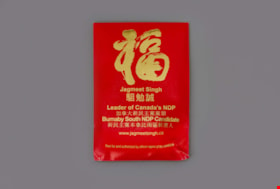
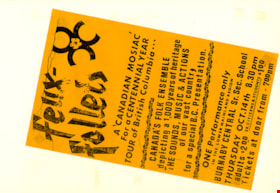
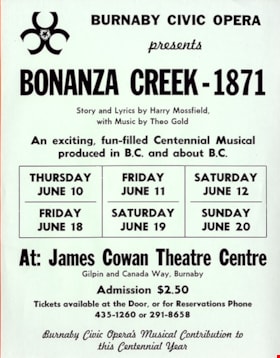
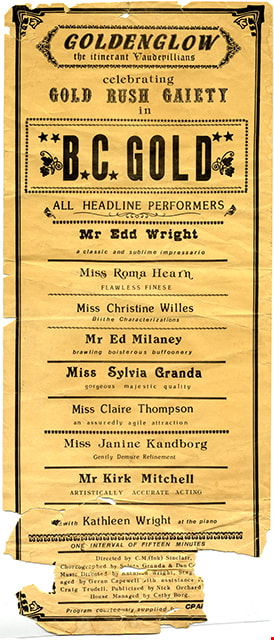
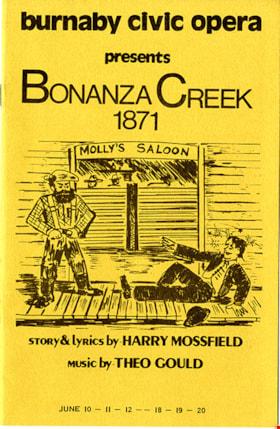
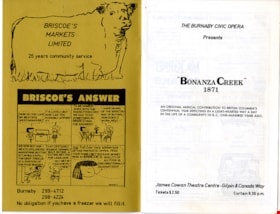
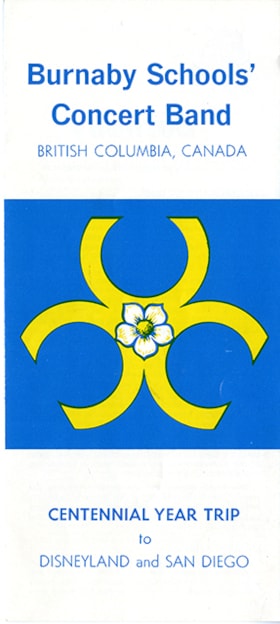
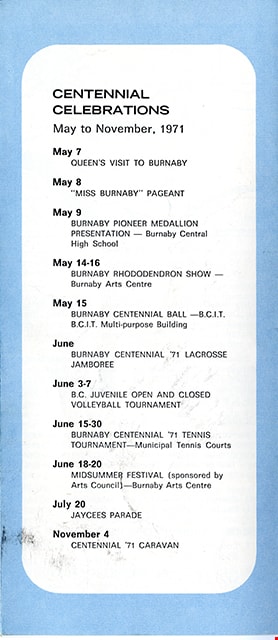
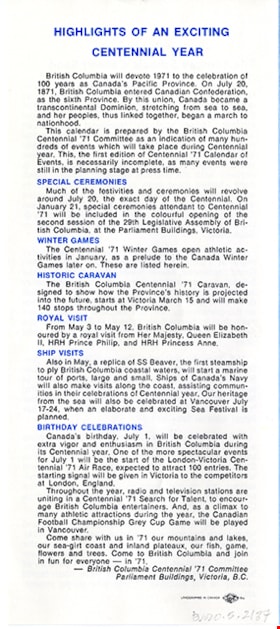
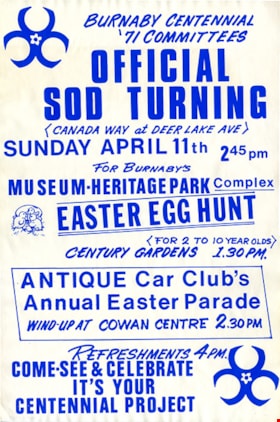
![Interview with Joanne Smith, [1986-2023] (interview content), interviewed 11 May 2023 thumbnail](/media/hpo/_Data/_BVM_Sound_Recordings/Oral_Histories/2023_0016_0005_001.jpg?width=280)
